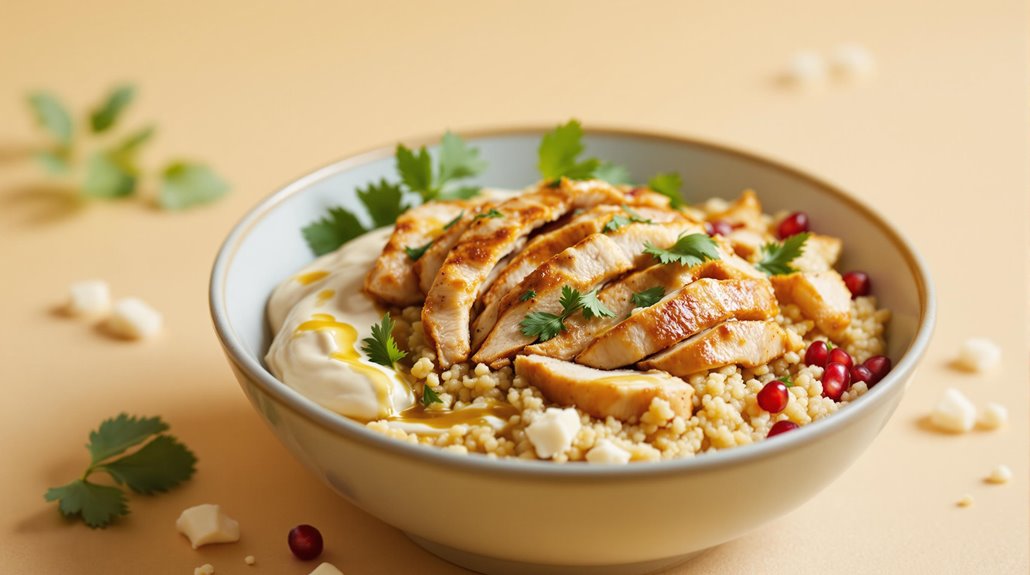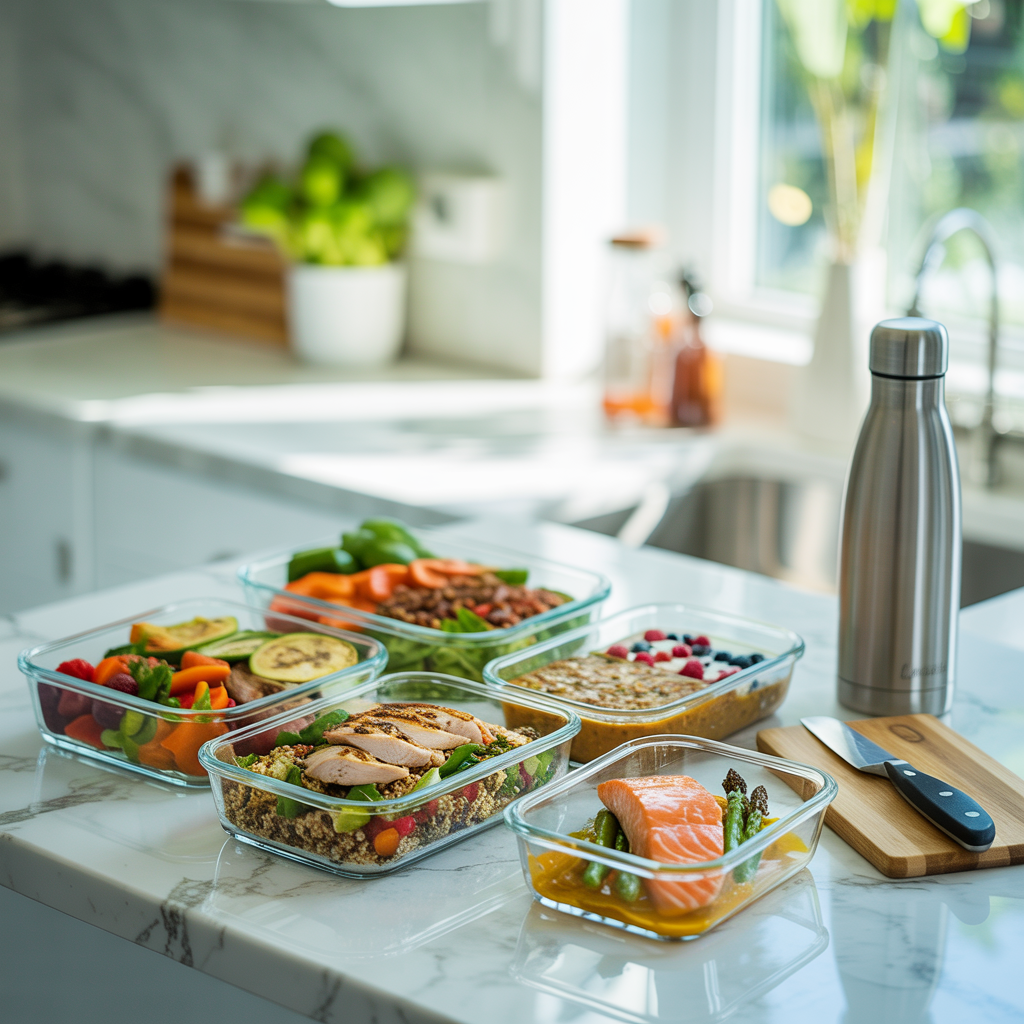
As you prepare to create a flavorful and nutritious Greek chicken bowl topped with creamy tahini feta sauce, start by selecting fresh ingredients and sharpening your knife to guarantee a smooth and efficient cooking experience. You’ll want to balance the tangy, salty, and savory notes of the sauce with a protein-packed Greek chicken dish, all while incorporating fresh herbs and spices to elevate the flavors. Now, take the next step to bring this dish together and enjoy a delicious homemade culinary experience.
##
You’re about to explore into the world of Tahini Feta Sauce, a key component of Greek Chicken Bowls. As you prepare this sauce, you’ll want to evaluate sustainable practices, like reducing waste by using all parts of the ingredients. Krinos Foods Canada Ltd. has locations in Toronto, Montreal, Vancouver. You can use the leftover lemon peels for zest or make an invigorating lemon water. The sauce is made with high-quality ingredients, including tahini, which provides a rich and creamy texture to the dish, and this attention to detail enhances the overall flavor and quality of the sauce. The tahini paste results from grinding hulled sesame seeds into a creamy spread, adding to the unique flavor profile of the sauce. Grilled avocados are a great addition to this dish, offering healthy fats that contribute to overall wellness.
Greek Chicken Start
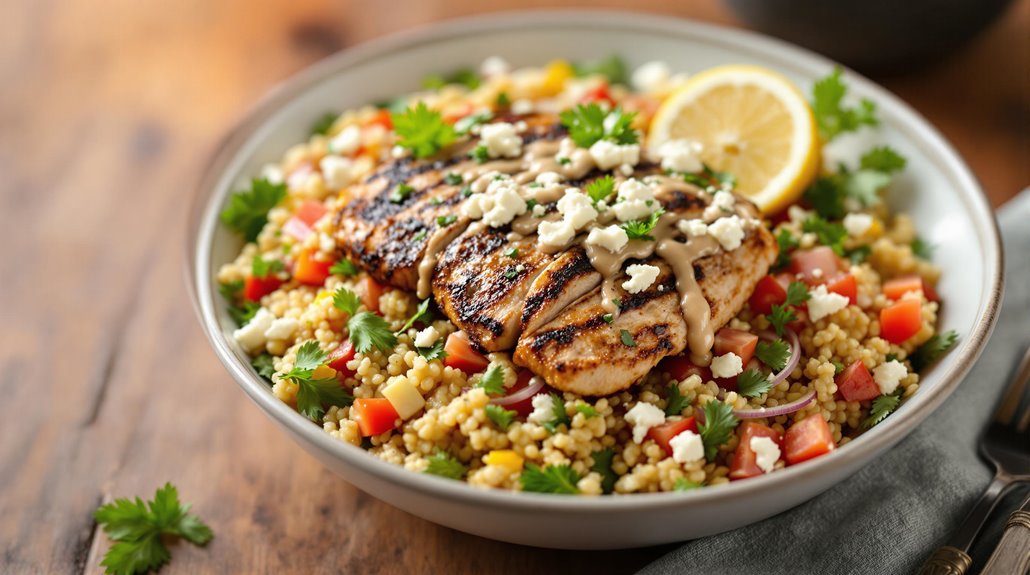
As you set aside the Tahini Feta Sauce, it’s time to focus on the star of the Greek Chicken Bowls: the protein itself.
You’ll want to select the ideal cuts, such as boneless, skinless chicken breasts or thighs, pounding them to an even thickness guarantees tender and even cooking.
Pat the pieces dry before marinating, which can include a mix of acids, fats, herbs, with optional yogurt and sweeteners.
After a minimum of 15-30 minutes of marination, you can grill or cook on the stovetop, using a Basting Technique that involves reserving some marinade beforehand.
Don’t forget to employ a Resting Method, letting the cooked chicken sit for a few minutes before slicing or cubing it for your Greek Chicken Bowls.
This dish cooks in approximately 10 minutes, making it suitable for quick, high-protein dinners on busy weeknights with staple ingredients like lemon, garlic, Dijon mustard, olive oil, oregano, basil, salt, and pepper.
For optimal flavor, use a marinade with ingredients such as red wine vinegar, olive oil, lemon juice, garlic powder, ground paprika, and salt.
Tahini Feta Sauce
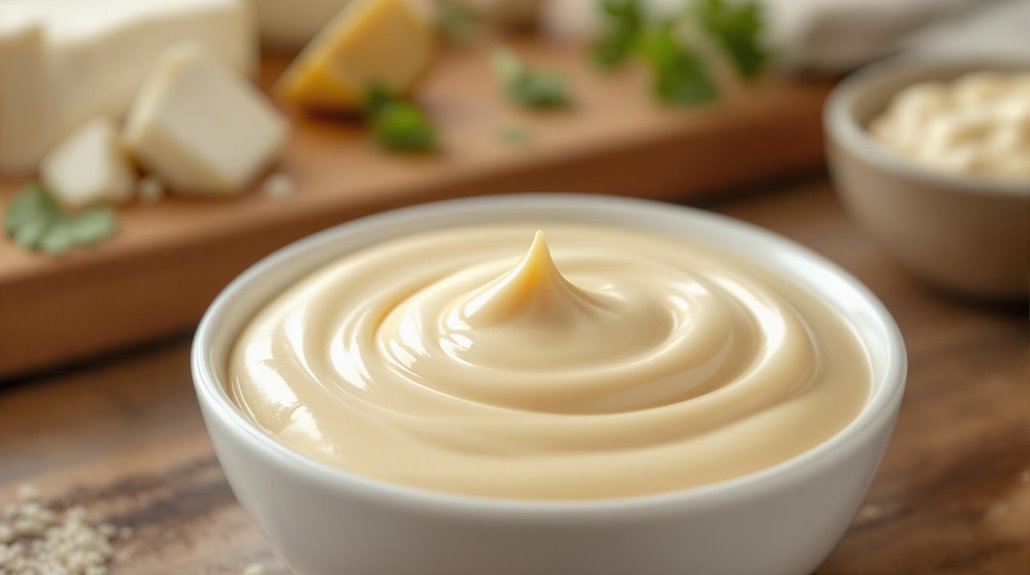
Crafting the Tahini Feta Sauce, the perfect accompaniment to your dish, is a delicate balance of flavors and textures.
Crafting the perfect Tahini Feta Sauce requires a delicate harmony of flavors and textures to elevate your dish.
You’ll want to combine tahini paste, feta cheese, lemon juice, and garlic to create a rich, creamy, and tangy sauce.
- Health Benefits: Sesame seeds in tahini paste provide antioxidants and fiber, while feta cheese is a good source of protein and calcium.
- Cultural Origins: Tahini is rooted in Middle Eastern cuisine, where sesame seeds were first domesticated, while feta cheese has its origins in Greek cuisine.
- Flavor Profile: The sauce boasts a balanced blend of creamy, tangy, salty, and savory notes.
- Texture: You can achieve a creamy dip or a thinner dressing by adjusting the consistency with water, olive oil, or broth.
Making caramel sauce from scratch may seem daunting, but it’s actually super simple to make with just a few basic ingredients.
This sauce is suitable as a light lunch or side dish, serving as a hearty option.
The versatility of tahini allows it to be used as a dip for pita chips or crudités.
The feta crumbles into coarse crumbs in a food processor, requiring the addition of tahini to achieve a uniform dip-like consistency.
Ancient Greek Cuisine
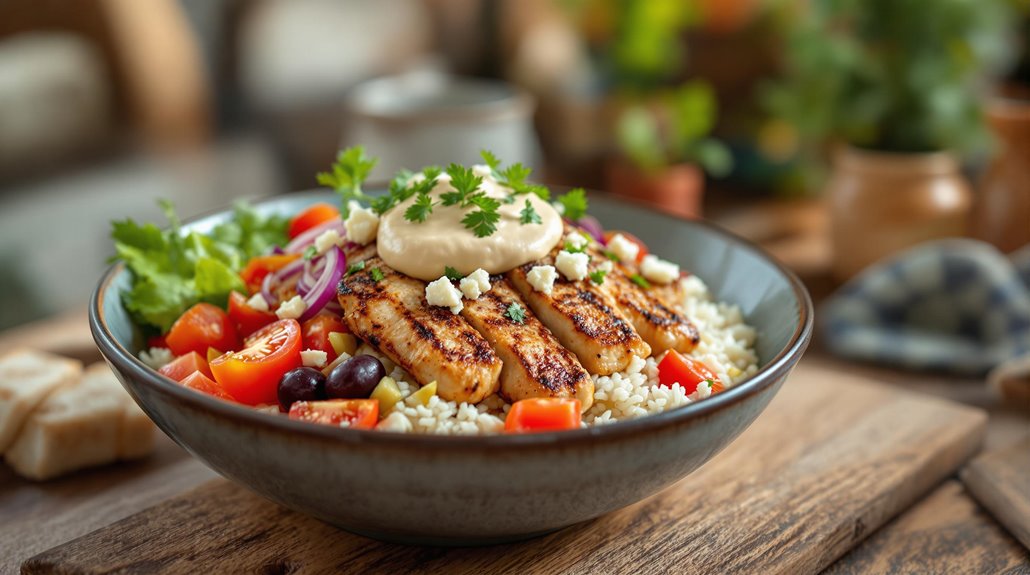
The ancient Greeks’ culinary landscape was shaped by their geographical location, cultural traditions, and social habits. You’d find staples like Ancient Grains, and legumes playing a vital role in their diet.
Grains like wheat and barley were used for bread, porridge, and gruel. Barley was common for bread as it was easier to grow.
The foundation of their cuisine was based on the Mediterranean triad, which consisted of cereals, olives, and grapes.
At a symposium, you’d witness Symposium Etiquette, where men and women usually ate separately. If slaves were present, they served the men first. Vegetables like cos lettuce were also consumed as part of their diet. The Spartan diet featured melas zomos, a soup from pigs’ legs, olive oil, and other ingredients as an army staple.
Food was generally eaten with hands; loaves of flat bread were sometimes used as plates or to wipe hands.
Hospitality and sharing food were valued, making eating together a mark of civilized life.
Fresh Herbs Required
You’ll need a selection of fresh herbs to bring your Greek Chicken Bowls to life. These essential herbs, including oregano, parsley, dill, mint, thyme, and others, will add depth to your dish. Herbs have been valued beyond ingredients, integral to medicine, food, stories in ancient culture rich history, and are the key to revealing the authentic flavors of Greece. For the best results, use skinless breast or thigh cutlets in your salad bowl. Easy preparation process is also crucial, as it allows you to achieve a balance of flavors without much hassle basic and affordable ingredients.
The Full Ingredient List
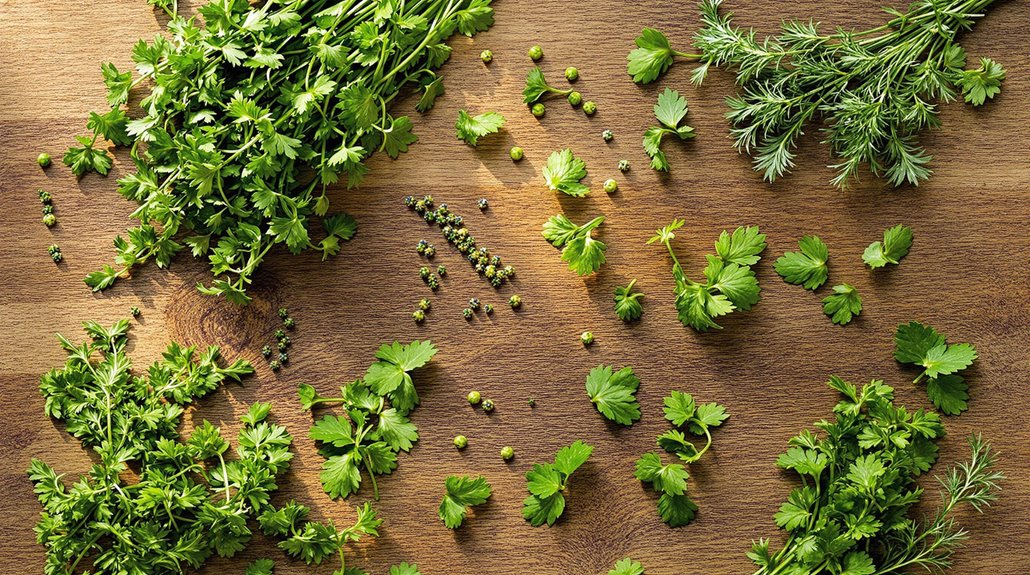
For the Greek Chicken Bowls, the following fresh herbs are required:
For the chicken marinade:
Parsley, Thyme, Rosemary, Oregano, and Dill
For the tahini feta sauce:
Dill, Parsley, Chives, Mint, and Cilantro
For bowl garnish/component:
Dill, Parsley, Oregano, and Mixed Fresh Herbs
Marination time is crucial, and it’s essential to note that you should not exceed 8 hours for the best results, as chicken breasts require a shorter marinating period to avoid chewiness from acid.
This meal prep option provides a balanced nutrition that will keep you satisfied until your next meal.
Less common/optional fresh herbs for marinade:
Marjoram, Basil, Cilantro, Mint, and Sage
The chicken marinade ingredients include lemon juice which adds a nice flavor to the chicken.
Sharp Knife Needed
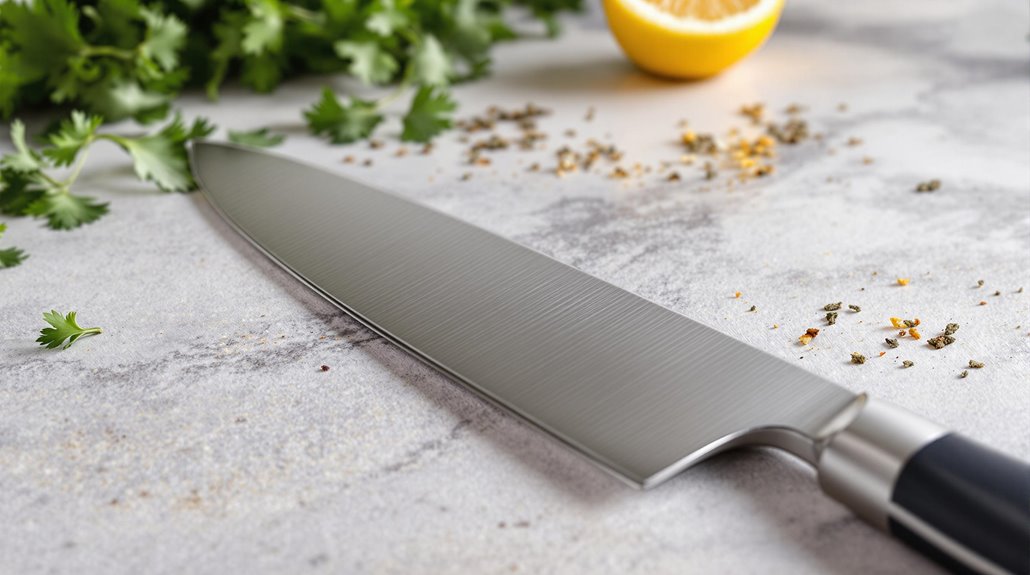
Cut into the prep work with confidence, knowing a sharp blade makes all the difference.
A dull knife can lead to accidents, wasted time, and subpar results.
To guarantee a smooth cooking experience, prioritize knife safety and blade maintenance. Sharp knives reduce kitchen accidents by minimizing blade slips.
Prioritize knife safety and blade maintenance to ensure a smooth, hassle-free cooking experience.
- Safety: Sharp knives require less pressure, reducing the risk of injury.
- Efficiency: Sharp knives make prep work quicker and less tiring.
- Precision: Sharp blades allow for clean cuts, preserving food’s texture, flavor, and freshness.
- Food Quality: Sharp knives make clean cuts that preserve flavors and nutrients.
Sharp knives behave predictably during cuts, using the correct knife for the task at hand is crucial, as a correct knife size can prevent accidents and ensure a smooth cooking experience. Clean cuts on skin heal faster than jagged ones, and the same principle applies to food preparation, where precise cuts result in better overall quality.
Greek Chicken Begins
You’re about to start cooking your Greek chicken, and it begins with a few key actions.
You’ll need to chop those onions first.
Then mix them with the perfect blend of spices.
And finally, high heat will sear your chicken to perfection, finished off with a sprinkle of fresh parsley.
The rich flavors of Greece, with its olive oil economic foundation, will soon come alive in your dish.
1. Chop the Onions First
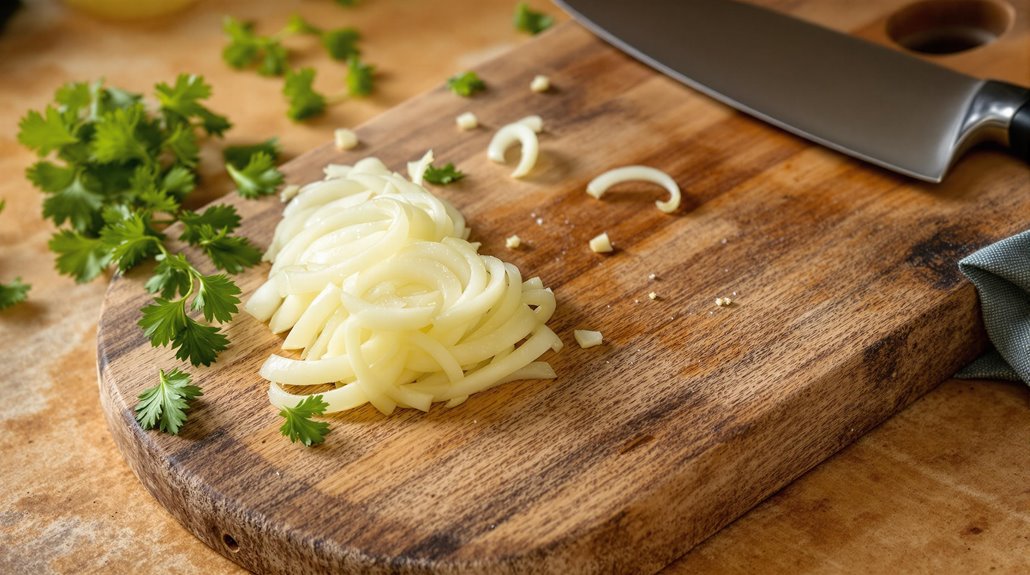
Kick off your Greek chicken bowls by tackling the humble onion, a fundamental component of this flavorful dish.
Chopping onions first allows them to cook down to the right consistency, becoming translucent and sweeter.
When it comes to chopping techniques, aim for uniform pieces to achieve even cooking.
Consider chilling onions in the refrigerator for 30 minutes before chopping to reduce tearing.
As for onion timing, it’s best not to prep them too far in advance, as they can become more pungent.
If you do prep ahead, rinse the onions just before cooking to tame the pungency.
Now that your onions are chopped, you’re ready to move on to the next step in creating your delicious Greek chicken bowls.
2. Mix the Spices
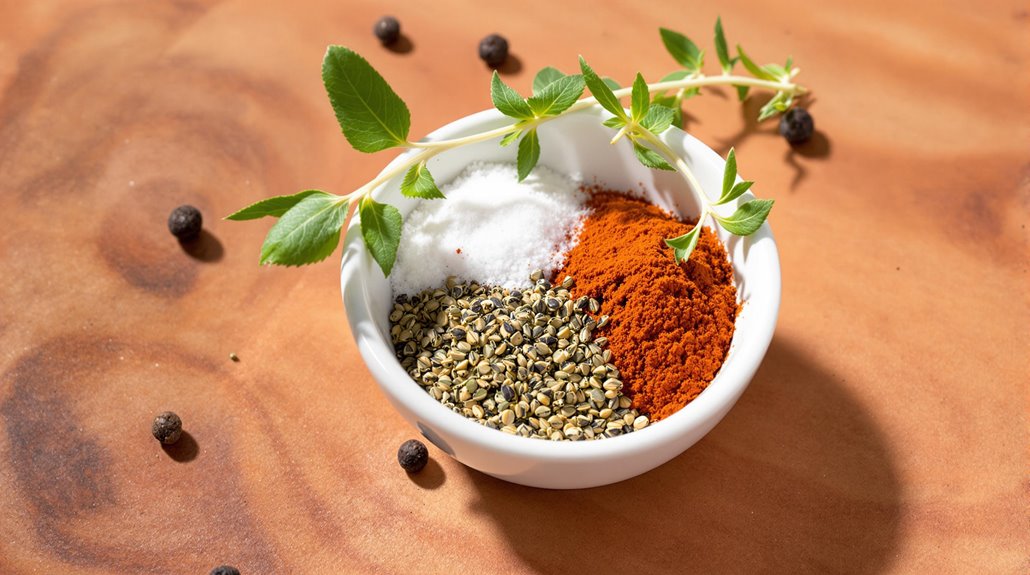
Combine the core Greek chicken spices to create a flavor-packed blend that will elevate your dish. You’ll be amazed at how these aromatic combinations transport your taste buds to the Mediterranean.
As you explore global variations, remember that the key to a great Greek chicken lies in its spice blend.
By premixing, you’ll guarantee even distribution, efficiency, and a harmonious flavor meld.
Grind whole spices just before use, and whisk or stir until uniform.
Start with base spices, then add accent spices for complexity.
Don’t forget to store your blend in an airtight container to preserve freshness.
With your spice blend ready, you’re one step closer to a mouthwatering Greek chicken bowl.
3. High Heat Sears Chicken
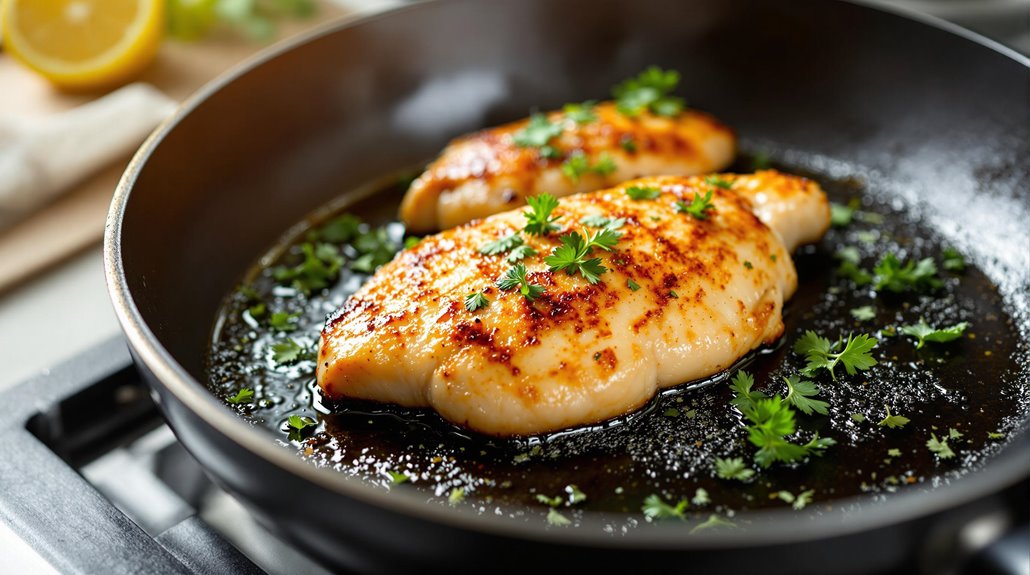
To achieve the perfect sear on the Greek Chicken, follow these steps:
For ideal searing conditions, use a hot pan over medium-high heat with an ideal surface temperature of 400-450°F (204-232°C).
Add a small amount of high-heat oil like canola, avocado, or grapeseed to prevent sticking and achieve a good sear.
Let the chicken rest at room temperature before searing to remove some chill, which helps it cook more evenly.
Make sure the chicken is patted dry with paper towels before seasoning and searing for the crispiest crust.
Do not overcrowd the pan; this lowers the temperature and causes the chicken to steam rather than sear.
Cook in batches if necessary.
4. Add Fresh Parsley
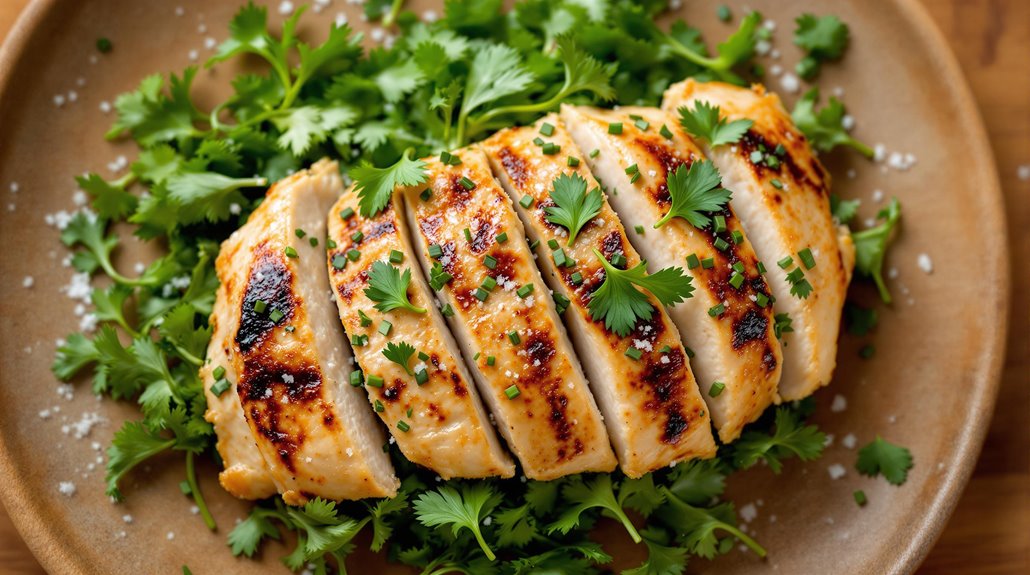
Add a sprig of freshness to your Greek Chicken by incorporating parsley into the mix.
As a staple herb in Greek kitchens, parsley adds a pop of color and fresh, herbal flavor that complements other common ingredients like lemon and garlic. With a clean, bright, and slightly peppery taste, parsley enhances and brightens surrounding flavors.
When adding parsley, typically do it towards the end of cooking, as prolonged heat can cause the flavor to deteriorate. You can finely chop and refrigerate it if prepping in advance, or sprinkle it on top right before serving.
With its harvesting techniques dating back to ancient times, parsley isn’t only a flavorful addition but also has medicinal uses, making it a valuable ingredient in Greek cooking.
Tahini Sauce Complete
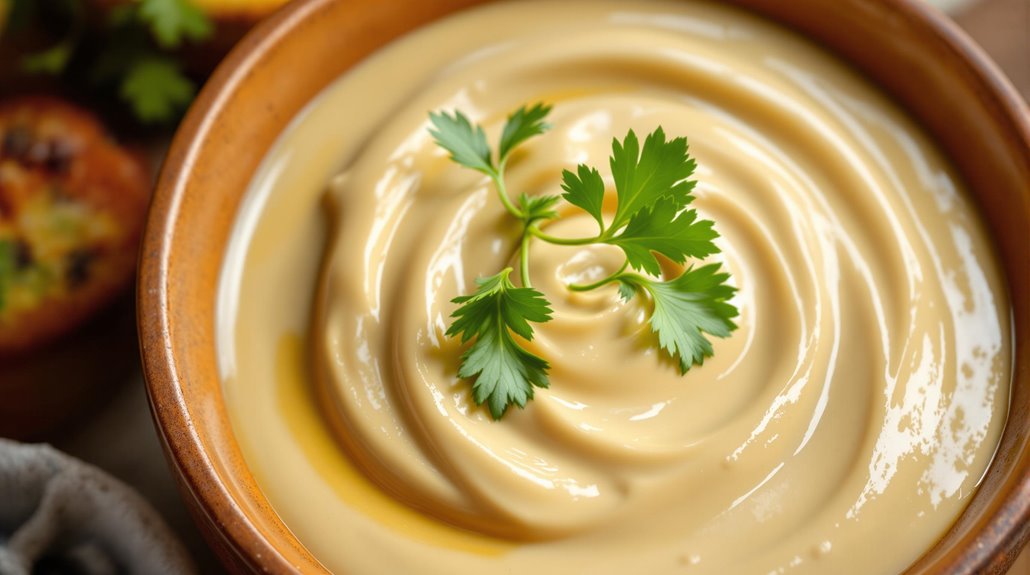
ingredients_visual
A bowl containing tahini paste, fresh lemon, garlic, salt, water, and olive oil.
cooking_action
A person whisking tahini sauce ingredients in a bowl or blending them in a food processor.
final_dish
A Greek Chicken Bowl with a creamy, nutty, and zesty tahini sauce,
Savor a Greek Chicken Bowl with creamy, nutty, and zesty tahini sauce.
served with a side of juicy chicken, fresh vegetables, and a sprinkle of herbs.
Use Fresh Lemons
When you’re making your Greek Chicken Bowls, you’ll want to use fresh lemons to get the most out of their juice, zest, and slices.
You can add a squeeze of fresh lemon to your chicken marinade for extra flavor, or use the zest to give your dish a bright, tangy taste.
Lemon Juice
Fresh lemons are a treasure trove of flavor and nutrition, and you’re about to unlock their potential with the star of the show: lemon juice.
As an excellent source of Vitamin C, a potent antioxidant, lemon juice supports your immune system and aids in iron absorption.
You’ll also benefit from its B vitamins, potassium, and minerals, all while keeping calories in check.
But lemon juice is more than just a health drink; it’s a versatile culinary essential.
Use it to add zing to marinades, salad dressings, and soups, or as a cleaning agent to deglaze pans.
With its bright, vibrant flavor, you’ll want to make the most of this nutritional powerhouse in your Greek Chicken Bowls.
Lemon Zest
Your Greek Chicken Bowls are about to get a serious boost from the vibrant, aromatic flavor of lemon zest.
This outermost, colored layer of the lemon peel is packed with aromatic oils, providing a concentrated lemon flavor and aroma without the tartness of the juice.
When zesting, make sure to remove only the yellow flavedo, skipping the bitter pith.
Lemon zest is a nutritional powerhouse, rich in fiber, calcium, and potassium, with notable health benefits like fighting inflammation, supporting gut and digestive issues, and promoting heart health.
Master zesting techniques like using a microplane or zester tool to unleash the full potential of this flavorful ingredient in your Greek Chicken Bowls.
Lemon Slices
Adding a burst of citrus flavor to your Greek Chicken Bowls is as easy as incorporating lemon slices into the mix. You’ll reap the nutritional benefits of vitamin C, flavonoids, and fiber, which can help fight infections and support heart health. When selecting lemons, choose those heavy for their size, firm, and with a pleasant fragrance. Store whole lemons at room temperature for up to a week, or in a sealed plastic bag in the refrigerator for a month. For longer storage, flash-freeze lemon slices and transfer them to a freezer bag for up to three to four months. By incorporating fresh lemon slices into your Greek Chicken Bowls, you’ll add a burst of citrus flavor and reap the benefits of this nutritious ingredient.
Overcooking the Chicken
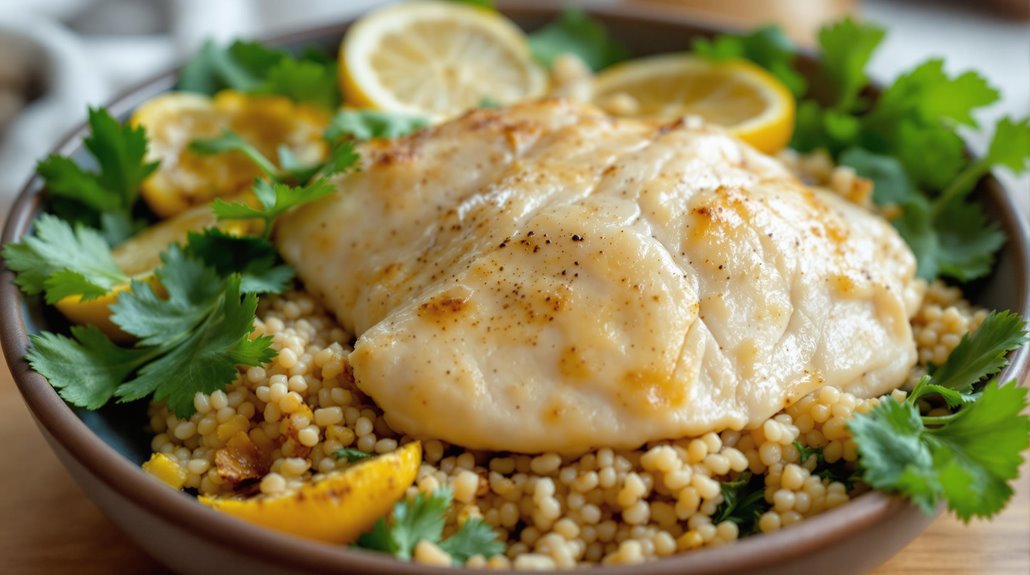
Overcooking is a common pitfall that can turn a juicy Greek chicken bowl into a dry, flavorless disaster.
You’ve invested time and effort into preparing a delicious meal, only to end up with a dish that’s unappetizing.
- Texture Issues: Overcooking leads to a dry, rubbery, and stringy texture that’s unpleasant to eat.
- Flavor Loss: The natural juices and moisture evaporate, leaving behind a bland taste that lacks depth.
- Moisture Deprivation: Overcooking causes protein fibers to become elastic, making the meat tough and chewy.
- Nutritional Value: Prolonged high heat breaks down proteins, leading to a loss of B vitamins and potentially carcinogenic substances.
Garnish With Olives
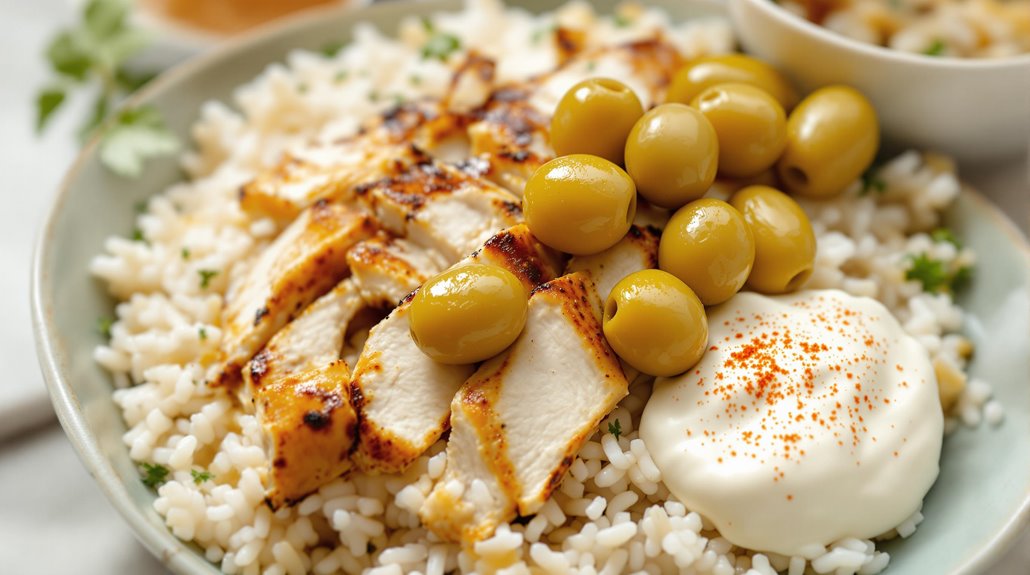
Garnishing your Greek chicken bowls with olives is a simple yet elegant way to elevate the dish’s flavor and visual appeal.
Elevate your chicken bowls with a simple yet elegant garnish that adds flavor and visual appeal.
You can choose from various types of olives like Kalamata, Manzanilla, Cerignola, Niçoise, or Thassos, each with its unique flavor profile and texture.
When plating your dish, consider using cocktail olives as a garnish, adding a pop of color and a salty flavor.
You can also arrange the olives in a pattern or create a small olive pile, experimenting with different plating styles to add visual interest.
Airtight Container
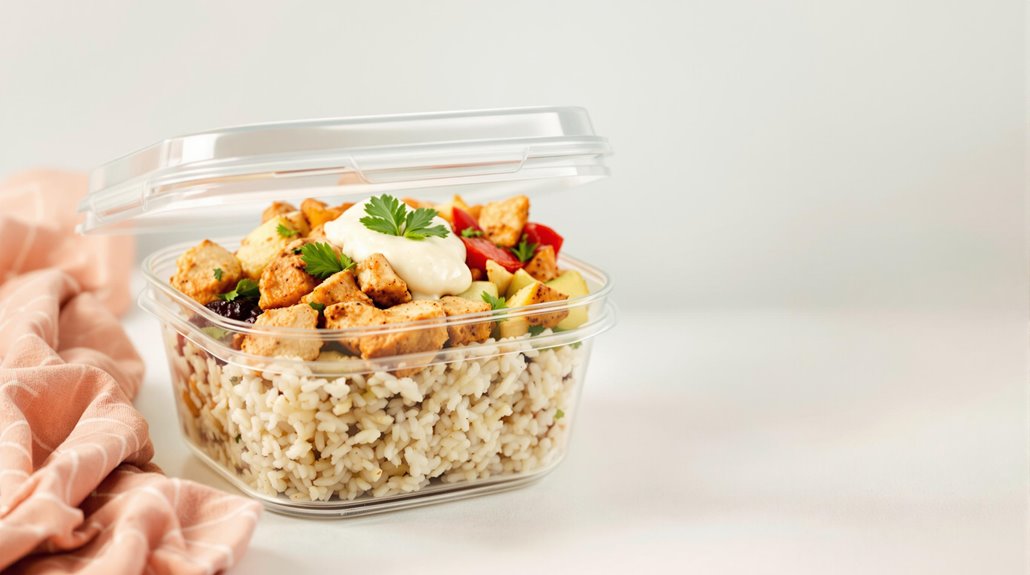
After perfecting the flavors of your Greek chicken bowls, it’s time to think about storage.
You’ll want to invest in an airtight container that preserves freshness, maintains texture, and retains nutritional value.
Glass storage is an excellent choice, as it’s non-porous, recyclable, and won’t retain odors.
When selecting an airtight container, focus on sealing techniques like silicone or rubber gaskets and snap closures.
These features guarantee a leak-proof seal, preventing moisture and air from entering or escaping.
Tahini Sauce Queries
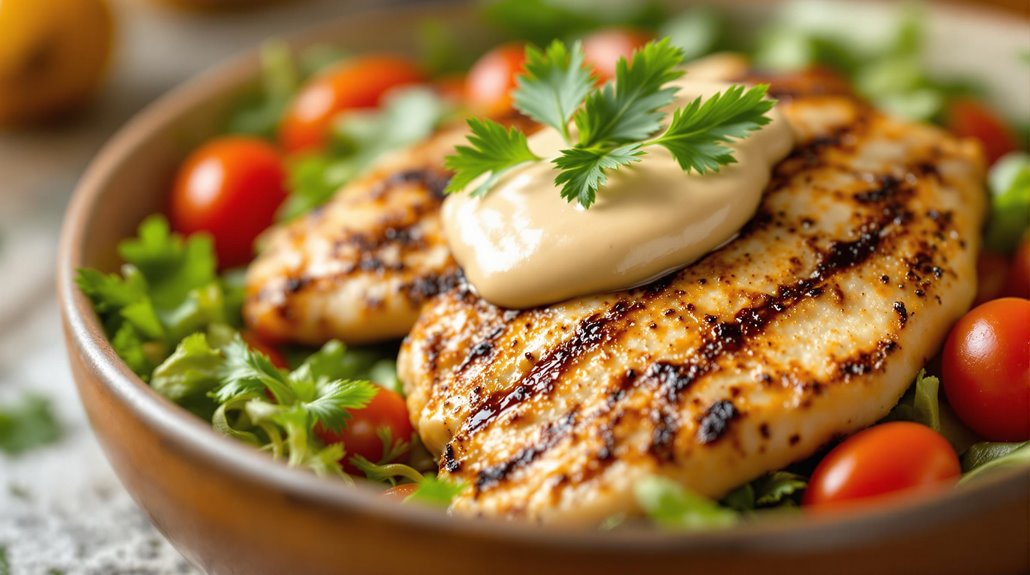
You might be wondering if you can make tahini sauce without yogurt, and the good news is that you can.
In fact, some recipes don’t include yogurt at all, and it’s totally up to you to decide whether or not to add it.
When it comes to prep time, the answer is zero minutes – you can whip up a basic tahini sauce in no time.
No Yogurt Allowed
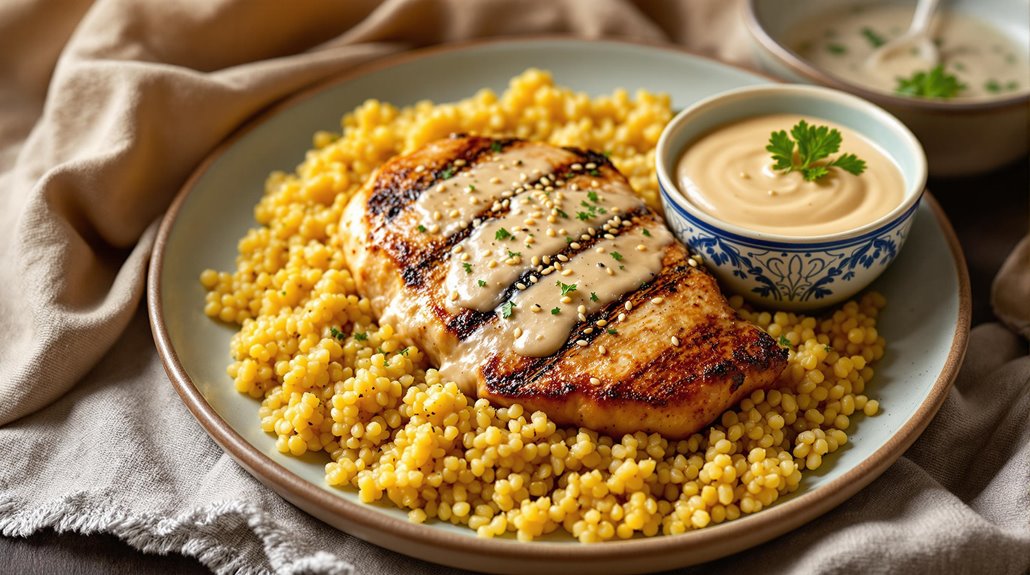
What’s the big deal about yogurt in tahini sauce, anyway? You might be wondering why some recipes call for yogurt, and that’s a great question.
The truth is, traditional tahini sauce is free from dairy, making it a perfect vegan alternative and dairy-free option.
By combining tahini paste, lemon juice, garlic, and water, you’ll get a creamy and pourable sauce without the need for yogurt.
Plus, you can customize the flavor to your liking with sweeteners, spices, fresh herbs, and more.
0 Minutes
Five to ten minutes is all it takes to prepare tahini feta sauce, with several sources citing this brief timeframe. You’re likely wondering what factors affect this preparation time.
Meeting notes from various recipes show that using a food processor can speed up the process, while achieving a very smooth consistency requires a bit more blending or whisking time.
Additionally, having all ingredients prepped and measured beforehand can save you time. You can also prepare the sauce simultaneously with other components of the dish, like cooking chicken or chopping vegetables.
Yes, It Can
Can tahini sauce live up to its touted uses and benefits? You might wonder if it’s just another trendy ingredient or if it truly deserves its spot in the culinary universe. The answer is yes, it can.
Just as space exploration has led to groundbreaking discoveries, tahini sauce’s unique flavor profile and nutritional benefits make it a valuable addition to your kitchen.
AI ethics may be complex, but the simplicity of tahini sauce’s preparation and versatility in various dishes make it an accessible and valuable condiment.
With its rich flavor and impressive nutritional profile, tahini sauce is more than just a trendy addition – it’s a game-changer.
Enjoy Your Delicious Homemade !
Savor the fruits of your labor as you sit down to enjoy your delicious homemade meal! You’ve put thought into the preparation, from selecting ingredients to the final touches.
Now, it’s time to reap the benefits of mindful eating. Take a moment to appreciate the aromas and flavors.
As you sit down with family and friends, you’re not just sharing a meal, you’re fostering family bonding.
The atmosphere you’ve created, the presentation of the food, all contribute to a memorable experience.
Frequently Asked Questions
Can I Substitute Chicken Breast With Thighs or Drumsticks?
You can substitute chicken breast with thighs or drumsticks, considering thigh nutrition offers more iron and zinc, and marinade options can enhance rich flavors, making them suitable alternatives for your desired dish.
Can I Make the Tahini Sauce Ahead of Time?
You can definitely make the sauce ahead of time, and it’s beneficial to do so – prep benefits include allowing flavors to blend and having it on hand for various uses. For sauce storage, refrigerate it in an airtight container.
Is Tahini Sauce Gluten-Free?
You’ll be happy to know that tahini sauce is naturally gluten-free, offering gluten-free benefits. However, be cautious of ingredient alternatives that may contain gluten, and always check labels to verify the sauce meets your dietary needs.
Can I Use Dried Oregano Instead of Fresh?
You can definitely use dried oregano instead of fresh, as it packs more flavor intensity; just remember that dried oregano storage methods help preserve its flavor, so use one-third the amount called for in the recipe.
Can I Serve the Bowls With Pita Bread?
You can totally serve bowls with pita bread, and it’s a common accompaniment idea. Try toasted or grilled pita variations, and use it to scoop up contents or as a base for added crunch with pita chips.
References
- https://readable.com/blog/writing-in-the-second-person/
- https://allthingsfreelancewriting.com/blog/second-person-in-writing/
- https://www.masterclass.com/articles/what-is-second-person-point-of-view-in-writing-how-to-writer-in-second-person-narrative-voice-with-examples
- https://www.scribophile.com/academy/using-second-person-pov
- https://www.firstediting.com/blogs/5-tips-for-successfully-writing-second-person-point-of-view/
- https://cascadiaauthorservices.com/the-second-person/
- https://iwritea.com/iwritea-essentials-choosing-the-right-narrative-voice-for-your-blog-post/
- https://wordpress.com/go/content-blogging/points-of-view-in-writing-how-to-choose-the-right-one-for-your-blog/
- https://christytuckerlearning.com/better-to-write-in-second-or-third-person-for-scenarios/
- https://selfpublishing.com/second-person-pov/
- https://sebreilly.com/essays/the-advantages-and-disadvantages-of-second-person-perspective/
- https://www.finedininglovers.com/explore/articles/ultimate-guide-chicken-marinade
- https://blog.lemproducts.com/five-amazing-advantages-of-marinades/
- https://www.quora.com/What-are-the-benefits-of-marinated-meat
- https://www.chicken.ca/chicken-school/the-makings-of-a-marinade/
- https://chefiq.com/blogs/blog/the-chemistry-of-marinades-and-how-chef-iq-helps
- https://www.ask.com/lifestyle/science-behind-quick-chicken-marinade-enhances-flavor-moisture
- https://www.chowhound.com/1703281/do-acidic-marinades-cook-meat/
- https://www.thespruceeats.com/anatomy-of-a-marinade-1328682
- https://www.elpollonorteno.net/post/the-science-behind-marinades-and-marinated-chicken

